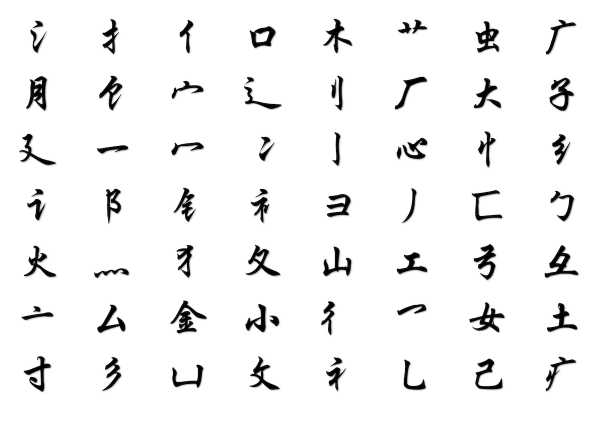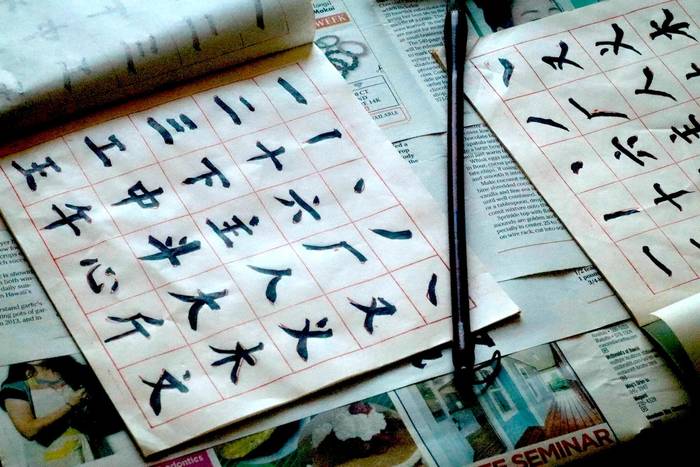12 Powerful Ways to Memorize Chinese Characters: A Complete Guide
Chinese characters often present the most daunting language learning challenge for English speakers. Their intricate structures and lack of phonetic clues can make them seem like an impenetrable forest of symbols. However, don't let this discourage you! With the right techniques and persistence, mastering Chinese characters is not only achievable but can become an exciting journey of discovery.
This guide presents 12 powerful methods to help you effectively memorize and retain Chinese characters. Whether you're a complete beginner or looking to enhance your existing study methods, these techniques offer a comprehensive toolkit that leverages your strengths as an English speaker. Get ready to unlock the fascinating world of Chinese characters and transform what once seemed impossible into an engaging and rewarding learning experience!
1. Understand Character Structure
At the heart of effectively memorizing Chinese characters lies a fundamental understanding of their structure. Unlike letters in alphabetic systems, Chinese characters are composed of smaller components that often provide clues to their meaning or pronunciation.
Chinese characters typically consist of three types of basic components:
-
Radicals: Building blocks indicating the general meaning category. For example, the radical 水 (water) appears in many water-related characters.
-
Phonetic elements: Hints about pronunciation, though be aware that it isn't always perfectly accurate.
-
Semantic components: Contributors to overall meaning.
Breaking down characters into these components makes them less intimidating and more logical. Instead of memorizing a complex drawing, you're learning a combination of simpler elements.
For example, let's look at the character 洋 (yáng), meaning "ocean": Radical: 氵(water radical), suggesting it's related to water Phonetic element: 羊 (yáng), hinting at the pronunciation Recognizing these components creates logical connections, making characters easier to remember and understand. Understanding character structure also helps guess the meanings of unfamiliar characters and becomes more valuable as you advance. Spaced Repetition Systems (SRS) are powerful tools for committing Chinese characters to long-term memory. This method is based on the psychological spacing effect, showing that we learn more effectively when we space our study sessions over time. SRS algorithms track your performance on each character and automatically schedule review sessions at optimal intervals. Characters you find difficult will appear more frequently, while those you know well will appear less often. This ensures you're always studying what you need most, maximizing efficiency. Anki: A highly customizable flashcard app that allows you to create your own decks or use pre-made ones. Quizlet: Offers various study modes and games to make repetition more engaging. Skritter: Focuses specifically on Chinese characters, including writing practice. When using SRS for Chinese characters, consider these tips: Include the character, pinyin, and English meaning on each card Add example sentences to provide context Use mnemonics or memory aids on the cards Include information about radicals or character components By consistently using an SRS app, you can efficiently build and maintain a large Chinese character vocabulary over time. Mnemonic devices are memory techniques that help you associate information you want to remember with something familiar. Creating vivid, often silly stories can be incredibly effective for Chinese characters. Break the character down into its components. Assign each component a meaning or image that's easy for you to remember. Create a story that links these meanings or images together. Example: 好 (hǎo), meaning "good": Components: 女 (woman) and 子 (child) Mnemonic: "A woman with her child is good" This simple story links the components' meanings to the character's overall meaning, making it much easier to recall. This approach leverages your existing vocabulary and imagination, making abstract characters more concrete. The quirkier or more personal the story, the more memorable it becomes. Let your creativity run wild - the goal is to create associations that stick, not historically accurate explanations. In our digital age, it might be tempting to focus solely on typing and reading Chinese characters. However, the physical act of writing characters by hand remains a powerful memorization tool, as it engages both visual and muscle memory, creating stronger neural connections and enhancing retention. Learning the correct stroke order is crucial as it: Improves writing speed and neatness Aids for recognizing different handwriting styles Helps understand character structure Use grid paper designed for Chinese characters to maintain proper proportions. Start with basic strokes and radicals before moving to full characters. Practice writing characters both individually and in context within sentences. Use apps like Skritter or websites like hanzigrids.com to generate practice sheets. Remember, the goal isn't perfect calligraphy, but to reinforce your memory of the character's form and meaning through physical action. Radicals are the foundational elements of Chinese characters, often providing clues to a character's meaning or pronunciation. Mastering these building blocks can dramatically accelerate your character learning process. While there are 214 traditional radicals, focusing on the most common 100 or so will cover the majority of characters you'll encounter. Radicals often appear in consistent positions within characters, like the "three-dot water" radical (氵) typically on the left side of water-related characters. Radicals aid memory by: Helping categorize characters by general meaning Allowing you to recall characters as combinations of familiar components Providing insights into character origins and evolution Start with the most common radicals. Learn the meaning and typical positions of each radical. Practice identifying radicals in new characters. Use mnemonic devices for tricky radicals. For example, the radical 心 (xīn, "heart") often appears at the bottom of characters related to emotions or mental states. By building a strong foundation in radicals, you'll find that new characters become much less intimidating and much more logical. Understanding the origins and evolution of Chinese characters can transform them from seemingly arbitrary symbols into logical, meaningful constructs. This approach not only aids memorization but also provides fascinating insights into Chinese culture and history. Chinese characters have evolved over millennia, often starting as simple pictographs (simple pictures) and becoming more stylized and abstract over time. Understanding a character's origin creates a memorable story behind its construction. For example, 安 (ān), meaning "peace" or "calm": Composed of 宀 (a roof) over 女 (woman) Originally, it represented the idea of a woman at home, signifying peace and tranquility. Resources for Character Etymology: Books like " Chinese Characters: Their Origin, Etymology, History, Classification, and Signification: A Thorough Study from Chinese Documents" by L. Wieger Websites such as HanziCraft or Chinese Etymology (字源) for Chinese characters Apps like Pleco often include etymology information for characters While you don't need to dive deep into the etymology of every character, exploring the origins of characters you find challenging can be both helpful and fascinating. Chunking is a cognitive strategy that involves breaking down complex information into smaller, more manageable "chunks." When applied to Chinese characters, this method can significantly enhance your ability to recognize, remember, and understand them. Breaking down complex characters into smaller components makes them more approachable and easier to memorize. As you progress, you'll notice many characters share common components, accelerating your learning process. For example, consider these characters: 清 (qīng) - clear 情 (qíng) - emotion 晴 (qíng) - sunny They all share the component 青 (qīng), which relates to the color blue-green. Recognizing this shared component can help you remember both the meaning and pronunciation of these characters. Character decomposition: Practice breaking down complex characters into their constituent parts. Component matching: Create flashcards with common components and practice identifying them in various characters. Character building: Start with basic components and practice combining them to form more complex characters. By implementing chunking and component analysis, you'll develop a more systematic approach to learning Chinese characters, making the process less about rote memorization and more about understanding and recognition. Visual and spatial memory techniques can be particularly effective for learning Chinese characters, especially for visual learners. These methods leverage our brain's ability to remember images and spatial relationships more easily than abstract information. Creating your own visual associations can be helpful for abstract characters that don't have obvious pictographic origins. This is similar to the mnemonic story method but focuses more on visual imagery than narrative. For example, 永 (yǒng), meaning "forever," resembles a person diving into water - imagine someone diving into an endless ocean. Mind maps are excellent tools for visualizing relationships between characters. Start with a central character and branch out to related characters, perhaps those sharing the same radical or those with related meanings. For instance, you might create a mind map with the character 水 (water) at the center, branching out to characters like 河 (river), 海 (sea), 洗 (wash), and so on. The memory palace (or method of loci) is a powerful spatial memory technique that can be adapted for learning Chinese characters: Choose a familiar location (like your home). Associate each room or significant object with a character. Create a vivid, exaggerated image of the character interacting with that location. For example, you might imagine the character 门 (door) as a giant door in your entryway. As you mentally walk through your memory palace, you can review the characters associated with each location. These visual and spatial techniques can make Chinese characters more concrete and memorable, especially for learners who struggle with abstract memorization. Reading extensively in Chinese is one of the most effective ways to reinforce your character recognition and understanding. It provides context for characters, helps you understand how they're used in real sentences, and naturally reviews characters you've learned. Benefits of Seeing Characters in Context: Reinforces the connection between form, sound, and meaning Shows how characters combine to form words and phrases Allows inferring the meaning of unfamiliar characters Starting with materials at your level is crucial. Graded readers are excellent resources: Controlled vocabulary with gradual introduction of new characters Often include pinyin and translations Various genres to suit different interests Apps like Pandaist offer graded short stories and articles, allowing learners to practice reading while naturally reinforcing character recognition and understanding. They often include features like integrated dictionaries and progress tracking, making them particularly useful for self-study. Try to guess the meaning of unfamiliar characters from context before looking them up. Keep a learning journal to note down new characters you encounter (graded reader apps often let you save words/articles for future revisit). Re-read passages to reinforce recognition of new characters. Challenge yourself with slightly harder materials periodically. The goal is to read extensively, not intensively. It's okay if you don't understand every character; the important thing is to expose yourself to characters in context regularly. Active recall is a learning principle that involves actively stimulating memory during the learning process. It's one of the most effective ways to move information from short-term to long-term memory. Flashcards: Use physical cards or apps like Anki or Quizlet. Try to recall the meaning and pronunciation before flipping the card. Write From Memory: Try to write characters from memory, then check your work. Teach Someone Else: Explaining characters to others forces you to recall and articulate your knowledge. Cloze Deletion: Create sentences with missing characters that you need to fill in. Character Recognition Games: Play games where you need to quickly identify characters. Start each study session with a quick review of previously learned characters. End each session by testing yourself on the new characters you've just learned. Use "dead time" throughout your day for quick recall practice (e.g., while waiting in line). Set reminders to do quick recall sessions at spaced intervals. Remember, the act of recalling, even if you get it wrong, strengthens your memory. Don't be discouraged by initial difficulty - it's part of the learning process. In our digital age, numerous apps and platforms have emerged to make learning Chinese characters more engaging and effective through gamification. These tools can add variety to your study routine and keep you motivated. Memrise: Uses spaced repetition and mnemonic techniques in a game-like format. Duolingo: Offers a gamified approach to learning Chinese, including character recognition. ChineseSkill: Provides various mini-games for character learning and sentence building. Skritter: Focuses on writing characters, providing stroke-by-stroke feedback. Gamification works by tapping into our natural desires for competition, achievement, and reward. It can: Make repetitive tasks more enjoyable Provide immediate feedback and progress tracking Create a sense of achievement through levels, points, or badges Encourage consistent practice through daily streaks or challenges While apps are powerful tools, they shouldn't be your only method of study: Use apps for quick practice sessions Complement app usage with handwriting practice Apply learned vocabulary in real conversations or writing Don't neglect reading practice with longer texts Keep in mind that apps are tools to support your learning, not replace more comprehensive study methods. Try to find a balance that works for you and keeps you consistently engaged with the language. Learning Chinese characters in isolation can only take you so far. To truly internalize them and understand their usage, it's crucial to apply them in real-life contexts. This approach not only reinforces your memory but also enhances your overall language skills. Benefits of contextual use of characters: Strengthens form, sound, and meaning connections Teaches character combinations and phrase formation Improves understanding of grammar and sentence structure Enhances meaningful memory retention Label items around your home or office with Chinese characters Keep a journal in Chinese, even if it's just a few sentences a day Change your phone or computer language settings to Chinese Follow Chinese social media accounts or news sites Chat with language exchange partners using Chinese characters Write shopping lists or to-do lists in Chinese Contextual learning creates multiple neural pathways to the same information. When you encounter a character in various contexts, you're not just memorizing it, but understanding its usage and nuances, which leads to better long-term retention. Moreover, using characters in real-life situations creates emotional connections and memory association, further enhancing retention. You're more likely to remember a character you used to order your favorite dish than one you simply memorized from a list. Mastering Chinese characters is a journey that requires time, effort, and the right strategies. The 12 techniques we've explored provide a comprehensive toolkit for English speakers: Understand Character Structure Use Spaced Repetition Systems (SRS) Create Mnemonic Stories Practice Handwriting Learn Radicals as Building Blocks Use Etymological Approach Implement Chunking and Component Analysis Utilize Visual and Spatial Techniques Engage in Extensive Reading Practice Active Recall Use Technology and Gamification Apply Characters in Real-Life Contexts It's important to recognize that everyone's learning journey is unique. Experiment with these methods to find your ideal combination. The key to success is consistency and patience. Celebrate your progress and don't be discouraged by setbacks. As you continue your studies, don't forget to make use of the wealth of resources available to you. From traditional textbooks to modern apps like Pandaist, which offers graded reading materials, there are countless tools to support your learning journey. 最后,祝你汉字学习成功!(Zuìhòu, zhù nǐ hànzì xuéxí chénggōng!) - Finally, wishing you success in learning Chinese characters!
2. Use Spaced Repetition Systems (SRS)

Popular SRS Apps for Chinese Characters
Creating Effective Flashcards
3. Create Mnemonic Stories

Technique
4. Practice Handwriting

Effective Handwriting Practice
5. Learn Radicals as Building Blocks
Learning Strategy
6. Use Etymological Approach
7. Implement Chunking and Component Analysis
Exercises for Practicing Component Recognition
8. Utilize Visual and Spatial Techniques

Creating Visual Associations
Mind Mapping for Character Connections
The Memory Palace Technique
9. Engage in Extensive Reading

Graded Readers and Resources
Strategies for Learning New Characters Through Reading
10. Practice Active Recall
Techniques for Self-Testing and Active Recall
Incorporating Active Recall into Daily Study Routine
11. Use Technology and Gamification

Popular Character Learning Apps
Balancing App Usage with Traditional Study Methods
12. Apply Characters in Real-Life Contexts
Ideas for Daily Character Use
Final Thoughts